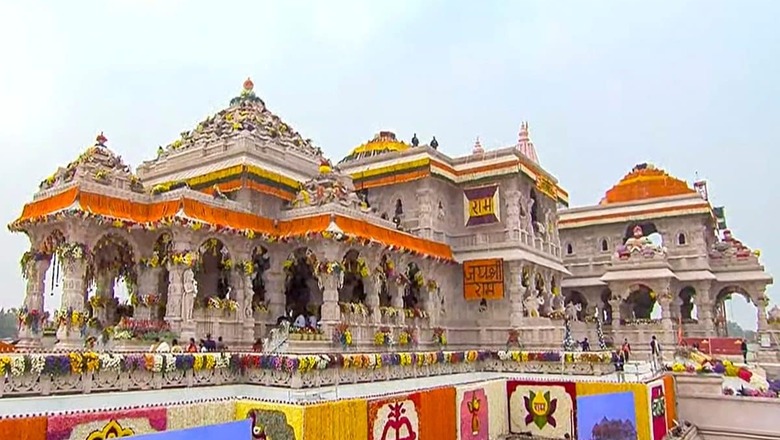
views
“Yes, these issues are not in our agenda at this time. However, that is because we do not have a majority in the house. We bow our heads in front of the number strength. However, we assure you that the task that we have taken in our hand, unless that national objective is fulfilled, we will not rest.”
These were the words of former Prime Minister Atal Bihari Vajpayee. The day was May 26, 1996. Today, Vajpayee’s promise has been fulfilled. The promise of a Ram Mandir was not just one for reviving the soul of Bhartiya civilisation, but also a core political vow of the Rashtriya Swayamsevak Sangh and the Bhartiya Janata Party. The opposition back then, led by the Congress, was trying to corner the BJP-led government for not fulfilling its three core ideological promises — of making a Ram Mandir at Ayodhya, revoking Article 370 and introducing a Uniform Civil Code. The opposition even ridiculed the fact that these promises did not feature in the then presidential address to parliament.
Twenty-eight years later, a civilisational renaissance is underway. Narendra Modi is Prime Minister and the BJP commands a handsome majority in the Lok Sabha. Article 370 is now history, and a Uniform Civil Code is on its way. 10 years since he first came to power, Bharat now has a bhavya Ram Mandir in Ayodhya, at the very site where Shri Ram was born. Prime Minister Narendra Modi on Monday performed the Pran Pratishtha of Ram Lalla in the Mandir which has been built in accordance with a Supreme Court judgement. The dream of a Ram Mandir has been fulfilled legally. The national mood is pulsating and exuberant. The opposition gave the consecration ceremony at Ayodhya a miss. Perhaps, it was too much for them to see the promise which Vajpayee made three decades ago being fulfilled by Narendra Modi.
Saffron flags with Shri Ram portraits can be seen across the length and breadth of the nation. Crores of families are celebrating the return of Shri Ram to his rightful abode by lighting diyas, performing puja and of course, lighting up the sky. It’s Deepawali all over again, only that this festival of lights is much grander and has evoked so many emotions among the people of India, especially Hindus. The myth of Shri Ram being a “North Indian” phenomenon has been shattered wide open. Prime Minister Modi’s pilgrimage to various temples in Southern Indian in recent days has shown how Shri Ram is the common binding factor for not just India, but the entire subcontinent.
Ram Mandir Movement Was Always Political
Amid the celebration, there are the party poopers as well. The opposition is making a huge fuss about the Ram Mandir Pran Pratishtha ceremony having been turned into a “political spectacle” by the BJP to earn electoral brownie points. The Congress, from denying the existence of Shri Ram to now worrying about the spiritual essence of the Mandir being eroded by politics, has certainly come a long way – albeit in the wrong direction. For a party that had no role to play in the Mandir movement, and whose Samajwadi allies in Uttar Pradesh are known for firing mercilessly at karsevaks, the Congress is certainly going out of its way to call out the supposed politicisation of the consecration ceremony.
Perhaps this would help: Yes, the Ram Mandir movement was always political. The Ram Mandir itself, apart from being a holy site of worship and a spiritual centre for Hindus, is also a living symbol of Bharat’s civilisational resilience. It is a testament to Dharma always prevailing over injustice and adharma. That is truly the essence of Shri Ram himself. Even if it takes over 500 years to reestablish, the final victory of right over wrong is a given. In this case, the wrong was the demolition of the original Ram Mandir by Babur and his army of marauders. It was an out and out act of adharma.
The reestablishment of dharma and restoration of any civilisational glory is impossible without a movement being political in nature. Of course, it need not necessarily be exclusively political. It can have many dimensions, including religious and cultural. Bharat is not a Western nation. Neither does India have a sense of unquestionable admiration for the model of democracy provided to it by the West, nor does it deem it necessary to wear the pretentious mask of separating “Church and State”.
In Bharat, politics can never be divorced from either religion or culture. Bharat has its own way of practising democracy. Today, its ancient culture and civilisational ethos are finding their rightful place in the national political discourse. This is what makes India different. Unlike others, Indian democracy is neither hollow nor without a solid foundation. The concept of “Raj Dharma” is now part of the mainstream narrative.
The Ram Mandir Pran Pratishtha ceremony marks the culmination of a national political movement. There can be no denying the fact that the RSS, BJP and VHP have played an instrumental role in making the dream of a Ram Mandir come true for crores of Hindus. Karsevaks laid down their lives for the Mandir. When such sacrifices have been made by so many people for a Mandir, it becomes practically impossible to not see the movement as political in nature. After the events of December 6, 1992, BJP governments in four states were dismissed by the Congress, which was in power at the Centre. After having acted with such brazen unconstitutionality, it does become a bit rich for the Congress to now preach against the politicisation of the Ram Mandir and the mass movement that preceded its construction.
Now that the Mandir has been built, we must be brave enough to accept certain facts. First, why is it that the Ram Mandir dispute was fast tracked at the highest levels of judiciary, and a favourable verdict was won only after 2014? The answer is simple. First, Hindus made it clear that their core beliefs were not subject to judicial oversight. Second, the BJP being in power with a majority on its own meant that the highest levels of government in India were pushing for an early resolution of the dispute. Third, the Modi government indicated that it would be open to the ordinance route to built a Mandir at the Ram Janmabhoomi should the Supreme Court return with an unfavourable verdict. Fourth, the BJP kept the issue of the Ram Mandir alive for three decades, and that itself is no small feat.
The realisation of the Ram Mandir dream in Ayodhya marks the arrival of the “political Hindu”. This is a Hindu who no longer accepts marginalisation in the name of vote bank politics. This is a Hindu that knows how to take what rightfully belongs to them. This is a Hindu that is proud of Bharat’s ancient civilisation, and is not unnecessarily enamoured by alien concepts of “secularism” and the complete elimination of dharma from politics. This is a Hindu that realises that the establishment of Raj Dharma is critical to India’s journey ahead.
Finally, the Ram Mandir is a symbol of Hindus’ political victory for the simple reason that the movement, for the past three decades at least, has been led by political forces. Narendra Modi was himself involved in organising the pan-India Ram rath yatras. Also, PM Modi is the one who fulfilled Atal Bihari Vajpayee’s promise of the BJP facilitating the construction of a Ram Mandir when it came to power with a majority on its own. To put it simple, yes, the Ram Mandir is the result of a political, religious and civilisational movement. It represents the biggest political triumph for Hindus in 500 years. It has been a long and incredibly costly struggle. However, the result of it all is now out there for us to see, and bow our heads to.
The views expressed in this article are those of the author and do not represent the stand of this publication.
















Comments
0 comment